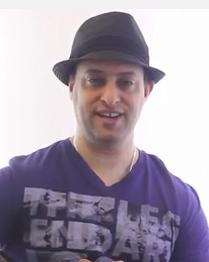Hey, guys. Claude Johnson here from guitarcontrol.com and I
want to go to part II of Beginner Jazz Guitar. We looked at
the basic chords in the C scale in the last video: C major 7,
D minor 7, E minor 7, F major 7, G7, A minor 7, A minor 7 flat
5 and C major 7. Now it’s going beyond chords and into chord
progressions.
When we look at the triads or the three-note chords, the most
common progressions are 1, 4, or 1, 4, 5. With jazz, with these
four-note chords the most common progression is 2, 5 or 2, 5, 1.
So in the key of C that would be D minor 7 to G7. That’s 2, 5
and then C major 7 would be the 1. It’s a 2, 5, 1. I’ll go over
the chord voicings in a second.
I want to say, first of all, that I like to use my thumb on some
of these. I know that’s not the classical approach to jazz
fingerings. A lot of jazz guys will do this, but I’ll go over
that, too, in a second.
Anyway, you can do something as simple as D minor 7, G7. Once
you get that four count just try to make it swing a little bit.
Just that can become like… I could do a whole other series on
rhythm. There are all kinds of cool jazz rhythms like the Charleston.
We get into that in the jazz course, the DVDs and stuff.
Let me just cover the chords so you can play this.
D minor 7, this is a real easy chord. It’s on the 10th fret.
I’m kind of cheating with my thumb here. I’m just barring.
You’re not playing the A string. Your thumb is going to mute
that. You could play it like this. The advantage of this is
your other fingers are a little bit more free. When you’re
like this is can be a little awkward to do that. The easiest
way to do it is just bar it, thumb it.
This voicing of the G7 is really cool because you’re not
playing the 5th. You’ve got root, 3rd, 7th and octave. It’s
kind of like your C shape here when you make a C7 open chord.
You slide up here. If you know your basic C chord and add your
pinkie on the G string 3rd fret, that’s the same shape.
I’m going to use another cheating thumb here. This one is like
your A minor. If you know your A minor basic chord, that’s going
to be slid up to here: 9th, 9th, 8th while your thumb hits the
low E string. This shape is your A minor. This is like an E minor
shape; kind of like this barre chord. That’s an interesting bit
of theory that if you have an E minor triad, the C and the bass,
that’s the same thing as your C major 7.
Same thing with this D chord that we played. Do this. This is
really like an F major triad here. Within these four-note chords
is like another triad, but with something else in the bass. It’s
very interesting that the minor 7 chord has a major triad with a
bass note underneath it and the major 7 chord has a minor triad.
I hope that makes sense. D minor 7, G7, there you go.
There’s your fist jazz progression.
Really, the way to learn — oh, one more thing. Let me just
go over this before I close-out the video. It’s important when
you play these chords you use proper voicing. You wouldn’t play
something like… It doesn’t sound bad, but when we play it here
notice that melody note just goes down one whole step and then
stays there. So that’s a big part of this.
But as I was saying, the real way to play jazz guitar, real
good sounding, professional jazz guitar as fast as possible
is to learn jazz standards. Standards are just another name
for a jazz song. That’s basically what we cover in the real
easy jazz guitar course. There’s a great jazz guitarist from
Texas. I think he moved actually somewhere now. I forget where
he moved, but he used to live in Texas.
He was actually a professor at some school down there and he
was generous enough to teach us on DVD really how to go through
the real book and understand the voicings and the chord melodies
and really put together jazz songs and we show how to play 10
jazz tunes along with all the basics that you would need to
know as well. So it’s really cool.
Check it out. Go to guitarcontrol.com/jazz.
Thanks for watching. Take care.





